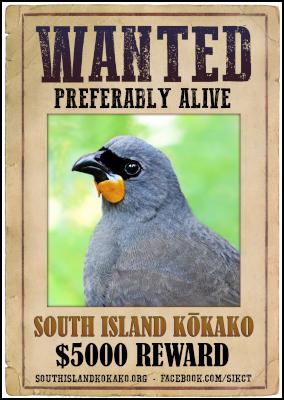Reward for Proof the South Island Kokako is Still Out There
MEDIA RELEASE

REWARD FOR PROOF THE SOUTH ISLAND KOKAKO IS STILL OUT THERE
The South Island Kokako Charitable Trust is offering a reward of NZ$5,000 for information resulting in confirmation that the South Island kokako is still alive.
The South Island kokako is an ancient endemic bird, unique to New Zealand and once widespread in our southern forests. It was listed as extinct until 2013 when credible sightings prompted reclassification as 'data deficient' (not enough data to be certain of extinction). It may well be the rarest bird on the planet. The bird’s reclassified status has given the Trust new reason and energy to continue the search for this hauntingly beautiful songster of the New Zealand wilderness.
Trust Chair, Dr Euan Kennedy, says the search is urgent.
“If South Island kokako still exist, there will be very few left. We need to locate them very soon so that conservation has a higher prospect of success.”
“In this search, we are attempting something quite new for New Zealand. We are passionate to find evidence of the kokako’s survival in the native forests of the South and Stewart Islands. To our knowledge no Trust has pursued a quest such as this.
“The reward we are offering for definitive evidence of survival is part of our strategy to broaden the search effort. We are inviting the public, birders and other Island backcountry users to be our eyes and ears everywhere in our southern forests.”
The Trust will appraise any evidence of survival received and will submit the most compelling information to independent expert analysis. The reward will be paid once a panel of New Zealand’s expert ornithologists agrees that the bird exists.
The Trust would prefer a verifiable photograph or other physical evidence of the bird over claims to have heard its calls.
Dr Kennedy explains that the calls of the kokako, both North Island and South Island birds, are very special.
“Kokako calls are so distinctively different, they will stop you in your tracks. Even so, the song of a tui is known to sound very similar. Sound recordings have yet to provide the evidence we need. That’s why we’re appealing to birders and backcountry users to find more convincing sign of the birds.”
The Trust is inviting observers to record possible encounters through its website (www.southislandkokako.org). It has already received encouraging reports over the past few years but rather than highlight such locations as they will reflect the places people go, this precious bird could in fact be found anywhere in its range, which are the native forests of South and Stewart Islands, particularly those where there has been sustained pest control.
Geoffrey Reid, a young environmentalist, has been looking for this ancient bird and says he heard it as recently as June 2016.
"I have been up and down the West Coast in and out the bush over the last couple of years and have heard birds in birds in multiple locations some even calling to each other. I have spoken to many local farmers and hunters who have heard or seen birds that perfectly match the description of a kōkako. I have absolute faith that this bird is still out there!
“We have seen this kind of thing before. The Takahe, Chatham Island Taiko and NZ storm petrel were all rediscovered. This could be another conservation success story where we find a handful of birds and bring them back from the brink of extinction."
Further information about the search and the reward is available on the Trust’s website www.southislandkokako.org.
To assist searching, the Trust is happy to e-mail regular updates of subsequent sightings on request. (info@southislandkokako.org).
Sound file from nzbirdsonline: http://nzbirdsonline.org.nz/sites/all/files/28%20-%20Kokako%20%28North%20Island%29.mp3
Further information on South Island kokako is available from: http://nzbirdsonline.org.nz/species/south-island-kokako
Extract from nzbirdsonline: “In early 1800s, [the kokako] occupied beech forests and low scrub above the tree line on both sides of Southern Alps from northwestern Nelson south to Fiordland and mixed podocarp forest on Stewart Island and some forested areas of Otago and Southland. They declined markedly after introductions of cats, ship rats and stoats, and were very rare by the late 1800s.”


 HMAC: HMAC Welcomes Government Health Changes
HMAC: HMAC Welcomes Government Health Changes Health New Zealand: Community And Collaboration Bring New Mental Health Facility Garden To Life
Health New Zealand: Community And Collaboration Bring New Mental Health Facility Garden To Life NZBS: Turn Up The Music, Roll Up Your Sleeve - New Zealand Blood Service Drop The Beats For Donation
NZBS: Turn Up The Music, Roll Up Your Sleeve - New Zealand Blood Service Drop The Beats For Donation School Library Association of NZ Aotearoa: Students Missing Out - New Research Exposes Alarming Disparities Across Aotearoa
School Library Association of NZ Aotearoa: Students Missing Out - New Research Exposes Alarming Disparities Across Aotearoa ANZCA: Health Reforms Raise Fears Of Two-Tier System And Workforce Shortages
ANZCA: Health Reforms Raise Fears Of Two-Tier System And Workforce Shortages Māpura Studios: A Matariki Exhibition At Historic Alberton House
Māpura Studios: A Matariki Exhibition At Historic Alberton House